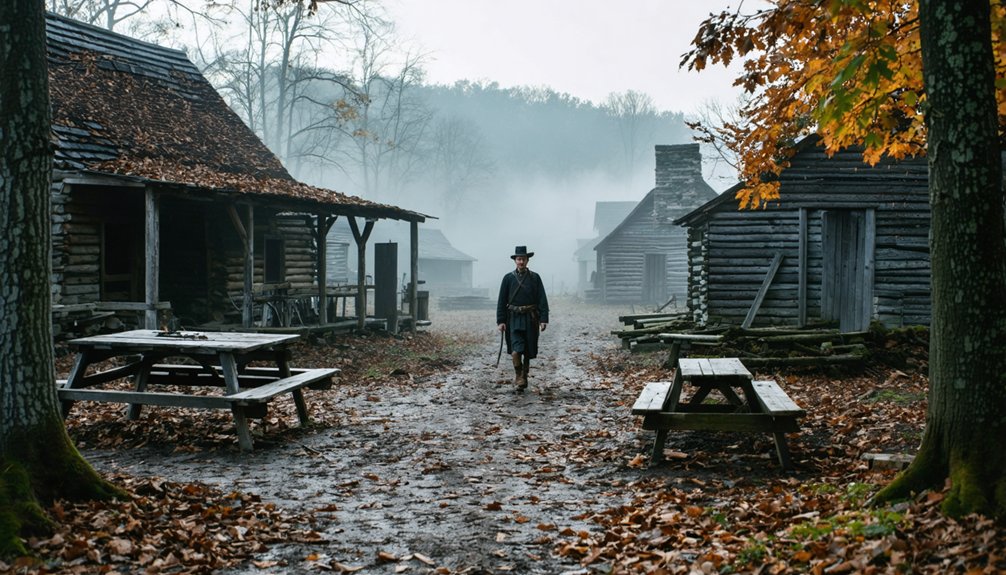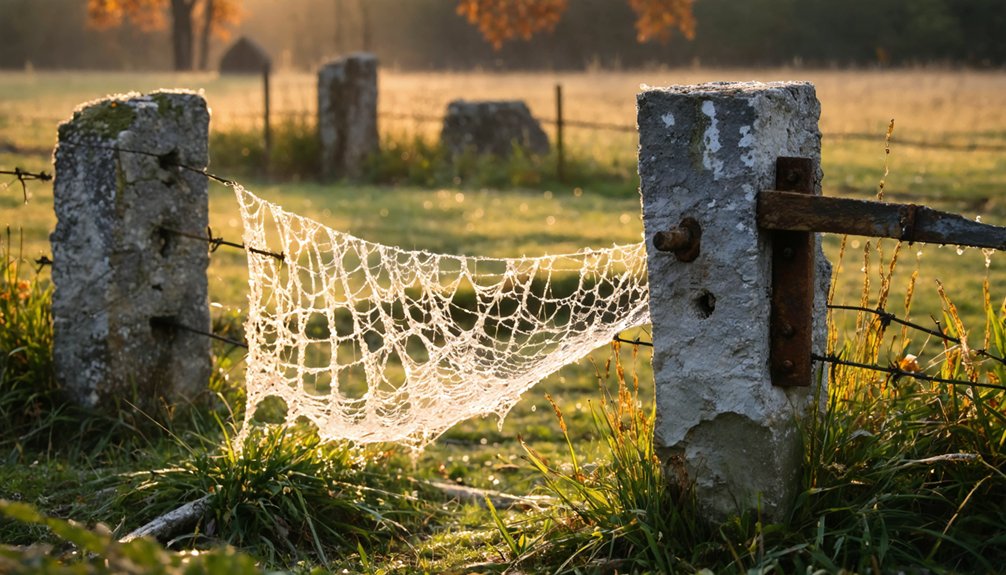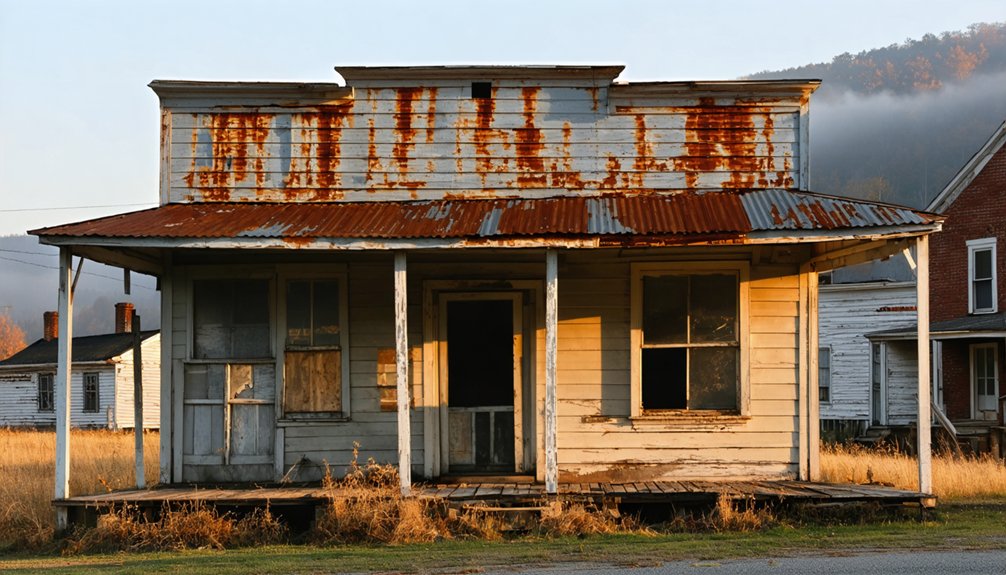You’ll find Fort Boonesborough, Kentucky’s earliest European settlement, nestled within today’s Fort Boonesborough State Park. Founded by Daniel Boone in 1775, this frontier outpost once bustled with 26 log cabins and four blockhouses before declining after 1820 as new trade routes emerged. While the original settlement is now a ghost town, you can experience authentic 18th-century frontier life through living history demonstrations and archaeological discoveries that reveal the settlement’s fascinating past.
Key Takeaways
- Fort Boonesborough declined after the Revolutionary War, transforming from a military outpost into a less-frequented trading post.
- By 1820, economic activity diminished significantly as new trade routes diverted commerce away from the settlement.
- Daniel Boone lost his Kentucky lands by 1798 due to land speculation issues, contributing to the area’s decline.
- The original settlement site is now preserved within Fort Boonesborough State Park, with only archaeological remains of the original fort.
- The transition from thriving frontier settlement to abandoned site exemplifies the common pattern of pioneer outposts becoming ghost towns.
The Birth of a Frontier Settlement
While Native Americans of the Fort Ancient culture had inhabited the area since 1400 AD, Boonesborough’s formal establishment in 1775 marked a pivotal shift in Kentucky’s frontier development.
You’ll find that Richard Henderson’s controversial purchase of 16 million acres from the Cherokee set the stage for Daniel Boone’s ambitious settlement mission.
The frontier challenges were immediate and intense. As you explore the settlement’s history, you’ll discover how 26 one-story log cabins and four blockhouses rapidly emerged from the wilderness under Boone’s leadership. Under the shade of Henderson’s Elm, settlers gathered for the first representative assembly west of the Alleghenies.
The settlement dynamics were shaped by the urgent need for defense against Native American resistance, while settlers grappled with isolation and resource scarcity. The Great Siege of 1778 tested the settlement’s fortifications and the resolve of its inhabitants.
Despite these obstacles, Boonesborough grew into Kentucky’s first fortified European-American settlement, becoming an essential waypoint for westward migration and tobacco trade.
Daniel Boone’s Vision and Legacy
Three pivotal aspects defined Daniel Boone’s ambitious vision for Kentucky’s frontier: establishing permanent settlements, creating viable trade routes, and fostering English-speaking colonization west of the Appalachians.
You’ll find Boone’s aspirations reflected in his blazing of the Wilderness Road through Cumberland Gap and founding Fort Boonesborough in 1775, which became gateways for hundreds of thousands of settlers.
While serving as a military captain and surviving the Great Siege of Boonesborough, he shaped the region’s early governance through roles in the Virginia General Assembly and local civic positions. His ingenious 160-mile escape from Shawnee captivity helped save the fort from destruction. Before retiring to Missouri, he lived at Boone Station from 1779 onwards.
His cultural significance extends beyond his frontier achievements – immortalized in John Filson’s 1784 book, Boone became a symbol of American pioneer spirit and rugged individualism, though he later struggled with land speculation and debt.
Life Behind Fort Walls
Inside the fortified walls of Boonesborough, daily life revolved around a tight-knit community of 26 log cabins housing multiple families, with four strategic blockhouses anchoring the corners for defense.
You’d find daily routines centered on securing essential resources – water from the river, food from gardens and hunting, and wood for fuel and building.
Community roles shaped every aspect of frontier life. You’d see women managing households while crafting soap and candles, men working as blacksmiths and woodworkers, and children gathering supplies and tending livestock.
Skilled craftspeople demonstrated traditional pioneer skills through activities like weaving, soap making, and woodworking.
Everyone shared in the fort’s survival, from preserving food through smoking and salting to maintaining defensive readiness through firearms training.
The community’s strength came from shared responsibilities, whether participating in harvest celebrations or standing guard against potential threats.
Today, visitors can explore these historical elements at Fort Boonesborough State Park to better understand pioneer life.
The Siege That Changed Everything
Before dawn on September 7, 1778, Shawnee Chief Blackfish launched a pivotal siege against Fort Boonesborough with 444 warriors and British-allied militia.
Led by Chief Blackfish, hundreds of Shawnee warriors and British militia descended upon Fort Boonesborough in a predawn assault.
You’d have witnessed Daniel Boone, recently escaped from Shawnee captivity, leading just 135 settlers in a desperate defense that would determine Kentucky’s future.
The siege tactics employed by both sides proved decisive. While the Shawnee attempted complex maneuvers, including tunnel digging and torch attacks, Boone’s sharpshooters effectively repelled multiple assaults. Heavy rains collapsed the attackers’ tunnel before it could reach the fort walls. The situation escalated when hand-to-hand combat erupted after failed negotiations on September 9.
After ten days of intense fighting that left 37 Native warriors dead, Blackfish’s forces withdrew. This failed siege, combined with George Rogers Clark’s victories, weakened Native alliances with the British and secured Kentucky for American settlement.
Within a year, Boonesborough became Kentucky’s first chartered town, though its hero Boone would eventually seek freedom elsewhere.
From Bustling Trading Post to Abandonment
Once Boonesborough’s military significance waned after the Revolutionary War, the settlement transformed into a bustling trading post where you’d find pioneer merchants exchanging goods with westward-bound settlers.
You would’ve seen tobacco warehouses, taverns, and various trades like blacksmithing and pottery flourishing throughout the community. Living historians still demonstrate these traditional crafts today at the fort’s replica.
Yet, despite this promising start, pioneer challenges began mounting. By 1820, you’d notice fewer travelers stopping as new trade routes diverted commerce to other settlements.
Daniel Boone’s failed land ventures and the collapse of the Transylvania Company’s authority dealt serious blows to the town’s stability. The shifting economic landscape, coupled with safer western territories opening up, drew people away. After losing his Kentucky lands by 1798 due to lawsuits, Boone permanently departed the settlement he had founded.
What was once a crucial frontier outpost gradually faded as settlers and merchants sought opportunities elsewhere.
Archaeological Discoveries and Preservation
Modern archaeological investigations have brought Boonesborough’s rich history back to life through systematic excavations and cutting-edge technology.
Through advanced archaeological techniques like ground-penetrating radar and magnetometry, you’ll find that researchers have uncovered the fort’s original layout, including stone chimney bases and post holes from the stockade gates.
Artifact analysis reveals fascinating details about daily frontier life.
Through careful examination of recovered items, we glimpse the routines and challenges of early American frontier settlers.
You’ll discover evidence of both struggle and adaptation through recovered items like English ceramics, hand-wrought nails, and lead ammunition.
The archaeological record shows how settlers maintained connections to civilization while forging a new life on the frontier.
Today, these precious remnants are preserved within Fort Boonesborough State Park, where they continue telling the story of Kentucky’s earliest European settlement and its complex relationship with Native American populations.
Modern-Day Time Travel at Fort Boonesborough

Stepping onto the grounds of Fort Boonesborough today, you’ll experience an authentic journey back to the American frontier of 1775.
Through immersive historical reenactments, you can witness blacksmiths forging tools, settlers cooking over hearth fires, and militia performing musket drills – all while costumed interpreters share tales of frontier life.
The sensory experiences are striking: smoke from cooking fires, the ring of the blacksmith’s hammer, and the rustle of period-correct clothing transport you to the era of Daniel Boone.
You’ll find these living history programs Wednesday through Sunday, April to October, despite occasional flooding challenges.
The site’s upcoming 250th anniversary in 2025 promises to showcase the fort’s significance in American expansion while offering you a tangible connection to Kentucky’s pioneering spirit.
Frequently Asked Questions
What Happened to Daniel Boone’s Personal Belongings From Boonesborough?
Lost, scattered, and dispersed through time, you won’t find Daniel Boone’s heirlooms at Boonesborough today. His frequent moves and legal troubles meant personal belongings weren’t preserved for their historical significance.
Are There Any Descendants of Original Boonesborough Settlers Still Living Nearby?
You’ll find many descendants with strong settler heritage still living around Boonesborough today, maintaining their family connections through community gatherings, genealogical research, and participation in local historical events.
How Did Winters Affect Survival Rates in Early Boonesborough?
While you might think pioneers could handle cold weather, winter hardships devastated survival rates. You’d face salt shortages, limited hunting, constant siege threats, and deadly exposure without proper shelter or supplies.
What Crops Were Initially Planted by the First Settlers?
You’d find early agriculture focused heavily on corn as the pioneer crop, with settlers also planting wheat, rye, and oats. They’d later diversify into hemp and tobacco for economic opportunities.
Did Any Famous Outlaws or Bandits Ever Visit Boonesborough?
Despite intriguing outlaw sightings and bandit legends elsewhere in Kentucky, you won’t find evidence of famous outlaws visiting Boonesborough. The settlement’s threats came from Native American raids, not outlaws, during its 1775-1780s peak.
References
- https://en.wikipedia.org/wiki/Fort_Boonesborough_State_Park
- https://en.wikipedia.org/wiki/Boonesborough
- https://www.britannica.com/place/Boonesborough
- https://www.explore.com/1480108/explore-ghost-towns-scary-road-trip-america-kentucky/
- https://kentuckyhistorictravels.com/2023/06/21/daniel-boone-the-man-the-myth-the-legend-part-one/
- https://www.youtube.com/watch?v=lGSU102iiRw
- https://www.nps.gov/parkhistory/online_books/colonials-patriots/sitee5.htm
- https://history.ky.gov/markers/fort-boonesborough
- https://kygs.org/first-kentucky-settlers-government-boonesborough/
- https://en.wikipedia.org/wiki/Siege_of_Boonesborough



